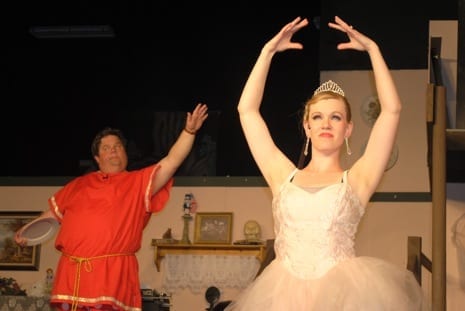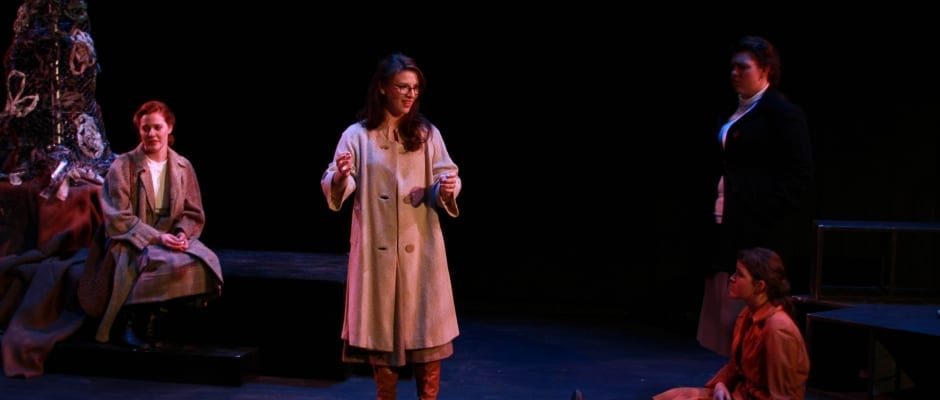SPRINGVILLE — I always enjoy a good night out at the theater, especially when I see a show for the first time. It’s so refreshing to go in blind, without any preconceived notions or expectations, and just see where it takes me. Springville’s You Can’t Take It With You was one such show. I did not even have so much as a plot outline or list of scenes to guide me, so it’s no surprise that it fit the bill and invited me right in.

Show closes September 29, 2012.
Set in the 1930’s, the George S. Kaufman and Moss Hart’s script tells the story of two families who couldn’t be more different. On the one side are the Sycamores and on the other side is the Kirby family. The Sycamores are an odd family made up of Mr. and Mrs. Sycamore; their daughter, Essie and her husband Ed; their other daughter, Alice; the housekeeper, Rheba; her boyfriend, Donald; Mr. De Pinna, the ice delivery man who came to drop off a delivery and never left; Grandpa, who collects snakes and dodges the IRS; and a compilation of many, many more adopted persons. The unique group has a bizarre routine—Mr. Sycamore makes fireworks in the basement with Mr. De Pinna. Rheba prepares corn flakes for dinner. Mrs. Sycamore spends her time writing a play or painting in the living room. Grandpa does only fun things —all the while Essie dances and makes candy while her husband plays the xylophone. Alice appears to be the only “normal” one, working in an office and engaged to a nice boy named Tony.
Enter family number two: Mr. Kirby owns his own business and works on Wall Street, practically married to his job. His wife enjoys the finer things in life and spends her spare time engulfed in spiritualism. Their son, Tony, is recently engaged to a nice girl named Alice. The two families move along at their own pace until that fateful day when their worlds collide.
Based entirely on family relations, the show brought together a wide variety of characters and actors, some of which struck my fancy more than others. I was quite taken with Lon Keith, who played Grandpa. His portrayal of the tax-evading, advice-filled, live-for-today man was superb and ideal. From stuttering over his lines to his shuffle as he walked across the stage, Keith gave a realistic and endearing performance. Christopher Bradford gave an enthusiastic performance of Boris Kolenkhov, Essie’s Russian dance instructor. He put gusto behind each line and kept a steady accent. Mark Taggart, who portrays Mr. Sycamore, and Bryan Cardoza, who plays Mr. De Pinna, perfectly portrayed the oblivious, wrapped-up in firework-making men.
But just as they do in a real-life family, some of the characters started to get under my skin—for example when Essie (Leisl Cope) was constantly twirling across the floor and plié-ing mid-conversation or Ed (Dominic Bills) was banging on the xylophone or creeping around in a mask. Alice (Joni Newman) was acting so bull-headed I just wanted to shake her. At these moments I had to remind myself that they were all just in character, and I really had to hand it to them for making their characters realistic enough to be annoying in a sibling sort of way.
Director Robinne Booth, who also starred in the show as Mrs. Sycamore, made sure to keep it all in the family. Everything from the mood music and decorations to the mannerisms of the actors created a realistic family setting. In fact, the entire comedy took place in the living room of the Sycamore home. Prop manager Ciera Warenski and set constructor Mark Taggart did an excellent job with the set. All of the props were juxtaposed together and harried, just like the characters. No detail was left out as they created the perfect, randomly realistic-looking set. Even the costumes, thanks to costumer Rochelle Zibetti, fit right in with the time period, enhancing the show without distracting from the action.
There were some scenes that had me outright laughing—such as the moment when a drunk actress is disguised as a piece of furniture; but there were also a few bumps, such as a live microphone backstage as well as some lulls in the action that had me glancing at my watch. The final scene seemed drawn out and I feel they could have driven the point home sooner, but the point remained the same: material possessions have no real meaning, as you can’t take them with you. When it really comes down to it, all that matters are the relationships you build and the memories you make together.
While the play didn’t completely win me over, I was impressed by the performance as well as the message it carried and am glad to add it to my cultural repertoire. On the way home my friend commented that she had never been to a play that was so homey. They just invited you right into their crazy, but loveable family—which set us off on a conversation about our own eccentric relations.
If you’re in southern Utah County, be sure to stop by and see the show—if only to remind you that there are a few crazies in every family, but you’ve still got to love them, quirks and all.






